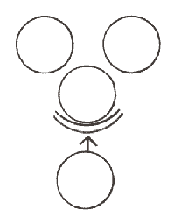Surviving A Multi-Opponent Attack
Part 5:
Maneuvering For Advantage: More Scenarios
By Christopher Caile
Editor’s note: This is the fifth of a series of articles exploring principles, tactics and techniques that can be used when confronted with multiple attackers.
4 – The Noose
There are times when three or more attackers are up close as in an elevator, hallway or entrance area. This example is similar to one in the last article, “The Loose Half Circle,” but here there is virtually no room to move.
If the attackers start the action, an attack could come from any direction or all directions at once. Thus, here more than ever, taking the initiative is necessary to give you a slight edge. Of course, be sure those burly friends who are getting up close and friendly are really there to attack you. An unprovoked assault against a group of visiting Russian wrestlers wouldn’t be greeted in a friendly fashion, and law enforcement wouldn’t be friendly either. So check your signals. Be sure before you act.
The closer the attackers are to you, and the more people there are, the more you have to condense your techniques and movement to be successful. This means doing two, three or more things at once, as part of the same movement. This cuts time and technically gives you a small edge. And, even if the space is tight you can often still move a little to create room to launch techniques, or to create a small distance between you and at least one attacker.

This scenario begins just as the action is starting when you have a little time to take the offensive. Being grabbed and jumped on will be covered later. Here, you, the defender, are confronted in a very tight space, an elevator. There are three men around you and the man facing you in the middle reaches out to push your chest.
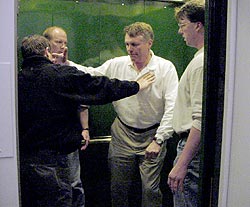 As seen in the second photo you move against the man who reached out to push you. Your technique is not a hard strike, but a lightening fast finger flick to the eyes (known as Splashing Hands in many Kung Fu systems). The particular technique is not important. It could be a technique to the testicles, a finger jab to the throat, a fast knuckle strike to the side of the noise, or even pocket change thrown into the person’s face. You are trying at minimum to cause a defensive reflex or distraction that will momentarily freeze the person in front.
As seen in the second photo you move against the man who reached out to push you. Your technique is not a hard strike, but a lightening fast finger flick to the eyes (known as Splashing Hands in many Kung Fu systems). The particular technique is not important. It could be a technique to the testicles, a finger jab to the throat, a fast knuckle strike to the side of the noise, or even pocket change thrown into the person’s face. You are trying at minimum to cause a defensive reflex or distraction that will momentarily freeze the person in front.
In this instance you use the fingers of your right hand to flick the eyes. While not bringing permanent injury, this technique can shock, disorientate, and cause pain and eye watering.
But, this is not your only technique. If you do just this and just stand there waiting, or turn to face another attacker, someone else will attack you in an instant, and it may be from behind. So turn a technique into two or more actions — the eye flick turning into an elbow strike which turns into another technique in the opposite direction — all performed together. The idea is to condense movement so you can accomplish in one move what normally would take two, three or four moves. This drastically speeds things up and allows you to address multiple attackers almost simultaneously.

Let’s look at this in more detail. Here, as you withdraw your arm from the finger flick you turn to the left to face the man on your left. As you do so, sink backward and down (cat stance) to attack the man on your right. This movement would normally be exceptionally dangerous since your back is now facing an attacker, but your right elbow from the same arm that did the flick can now be used as a weapon striking backwards (into the ribs or face) to hit the man to your right (now behind you). You can also add a simultaneous backwards head butt (into the nose or side of the head) and a foot stomp onto the toes of this same person — a quick, powerful combination.
In one continuous motion you have dealt with two opponents and are facing the third. The same arm that had elbowed could also now proceed forward into a punch or virtually any technique. This is often referred to as the “Principle of Continuous Motion,” or the “Principle of Economy of Motion.” (1)
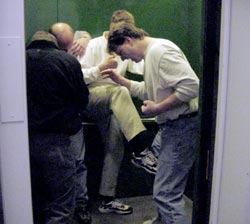
By moving backward to attack one opponent and sinking into a stance with the hips pushed backward you have also created a small, momentary space to your front. In the scenario presented here the next technique is not done by the arm or hand (thus breaking the continuous motion of the right arm), but is a front kick into the groin of the third attacker. (2)

You now move in on this attacker, who has bent over in pain, and control/spin his body into the person who was first in the middle (who you initially eye flicked). That person is momentarily blocked. You have now dealt with him twice in a fraction of a second.
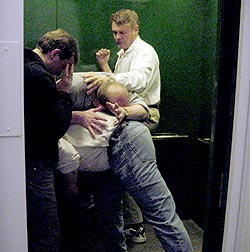
In the final photo you have completely turned again to address the man who had just before elbowed, head butted and stomped on — his second visit too. In this illustration the man is still reeling in pain, so he is easily pulled forward on top of the man already turned and bent over. One attacker is now bent over the second and both are momentarily out of action. The two block the path of the man who was originally in the middle – his third visit. You now wait for any further action. (Photo 6)
Although this is a simplified scenario it illustrates important principles of movement that are useful in tight spaces.
5 – The Wedge
In this situation the lead attacker approaches first and is out front of other attackers. The attacker can also be standing in front of you but positioned directly in front of two or three others. While this is still not a great scenario in the midst of a very bad situation, at least it gives the defender some advantage up front. In either case the leader is the only person within reach of you and his position is also blocking the others.
If the first attacker is in front and separated from the others, this is an ideal time to try to deal with him quickly (see Part 2, “Severing The Head Of The Serpent”). If you are successful you might persuade the others to opt out of the conflict. You can also use his body as a shield, a barrier or knock him into others to disperse them just like racked pool balls at the start of a game (Part 2, “Use Your New Friends”).
If the attacker is standing directly in front of others, if you don’t immediately defeat him at least push him backwards into the others (see Part 3, the movement principle of “Bump and Run”).
In either case, the disrupted formation of attackers can then be dealt with. However they are dispersed, use movement to stay on the outside and to align one in front of another, and move in order to minimize the number close to you. Limit your exposure. Don’t get between them. If you do break out using the movement strategies illustrated above.
6 – Runners and Chargers
For analysis purposes we first examined a series of possible fixed static formations and how to use movement to address them. In this sixth section we “turn the tables” so to speak and discuss various movement strategies in situations where the opponents are rapidly moving — towards you.
A runner is someone who is actually running, but since he is running his attack is more likely to be a tackle or take down. A charger, however, is someone who was once lingering outside your reach but who suddenly moves (charges) towards you and attacks. A runner can turn into a charger.
Discussed below are various strategies to be used in these type of attacks and how to get past or through them (if there are several persons) so you aren’t overpowered, tackled or taken to the ground. If you are successful the attacker or attackers will slow, stop, turn and move back towards you at a slower pace. At this point the situation reverts to the various strategies discussed above. Here, however, we focus just on the initial aspect of how not to be overwhelmed by a running or charging attack.
Let’s start with a single attacker. The faster someone is approaching, the more momentum and often the less stability he has. This can be used to your advantage, but you can’t just stand your ground. The strategy is to wait until the last moment and then quickly move out of the way, outflank the attackers, pivot and don’t be there. The same strategy can be used against several attackers if they are bunched close together and is similar to “The Wall” or “Loose Half Circle” discussed earlier.
Another alternative against a fast approaching attacker, and one often used in aikido, is simply to wait until the last moment and then drop to the ground at the feet of your attacker so he will trip over your body.
When I was teaching karate in Peoria Illinois in the late 1960’s, I once had a student who had played football in college and then was a semi-professional. In freefighting he was especially adept at one technique similar to this. He would suddenly explode into your feet, a quick roll that would totally upend you. It was so fast and so powerful that unless you knew it was coming, you were totally surprised.
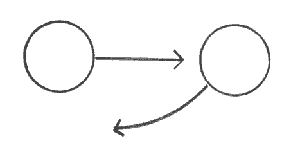
Another strategy against someone running toward you is to move quickly towards him at a wide looping angle. This cuts the time and distance he has to react, and forces him to slow down as he tries to change the direction of his momentum. But don’t move too soon. Wait until he is eight or ten feet away. If you move sooner it is considerably easier for the attacker to adjust.
If two or three people are all running at you from a distance and they are a little spread out, you can also react as you would in the “The Wall” or “Loose Half Circle” examples — again go to the outside to outflank the group. Often a pivot added at the end is just enough to let the outside person’s momentum take him past.
If the group is staggered or further spread out so you can’t outflank them to the side, you have to become especially evasive. Don’t let them know what you are doing by moving in a straight line. The strategy is to work like a punt returner in football, move between a gap in their formation, or zig one way towards one person out front and zag toward the gap behind him.
If the attackers rushing you are spread out behind one another, there is another strategy available.
Mike Hawley was asked this question by a relative of his who worked as a prison guard after he had experienced this very situation. In aikido class Mike demonstrated how your don’t try to stop the first or second attacker. You stand relaxed and as each closes in, you open your body and pivot around to let him pass (often using your outstretched arms to help) and then deal with the next. Only when you get to the last man do you deal with him.
The reason is simple. The first one has a lot of momentum and energy with him and can knock you over or tie you up easily. The others will just jump on. But if you can get past the first runners, they will take time to slow and then reverse direction. This gives you time to deal with the last person first, then the second to last, etc.
In group confrontations defenders also often have to deal with attackers who charge in. The actual distance moved might be short, but when combined with an attack it is quite threatening. The strategy is the same as against runners — don’t be there because if you are, you can be overpowered, grabbed or taken down. Again the strategy is to turn, move or pivot to the side of the attacker.
A friend of mine, Sensei Paul Williams, is one of the most powerful and accomplished freefighting (point and semi-contact) competitors I have ever known. He is a master at the use of angles, turns and spins. I am often amused at competitions when I see how he deals with a fast aggressive attack — by spinning to the outside or behind. The attacker often looks stunned, confused at where his target has gone, until notified a split second later from some angle that Paul is definitely still around. Paul proves that this type of movement strategy is as effective in one-on-one situations as it is against multiple opponents.
A simple pivot or turn is easy to demonstrate. In the first photo two opponents are facing each other. The defender at right, has his right foot forward. In the next photo, the defender has merely pivoted to the side on this same foot. It doesn’t matter what the attack is, and the faster the attack is (the more momentum it has) the easier it is to get to the outside. (3)
A similar technique is to intercept an attack, such as a stomach kick, with a block that guides the attack past you and allows you to move to the side of the attacker to counter. In Seido Karate there is a series of techniques known as Seido Strategy that teaches this movement strategy. For example, if you are standing left foot forward with your hands in front of you and an opponent does a left front snap kick, you respond with a left down block (right hand up protecting your face) as you step forward (right foot) at an angle to the right. The kick is guided past and you end up at the exposed side of the kicker, well within range for counter punches and/or a take down.
If, however, the charging attacker is trying to hit your head with something, a fast drop to the ground under his feet would also work. But don’t stay there, for other attackers may be approaching.
The next and last article in this series will discuss special situations, such as going to the ground, of if attackers catch up with you and all grab you.
Footnotes
(1) Karate masters have always talked about how students’ techniques progress over time. At first students learn to first block and then counter (two counts). Later a technique might first block and then continue on to become a counter (One and one half counts). Finally, more mastery can result of a single technique being a simultaneous block and counter (one count). This is another example of this principle.
(2) This sequence is illustrated in Pinan Two and Four. The defender turns left but sinks back and down into a cat stance. In both kata the right elbow is pulled back in what the casual observer assumes is preparation for the technique to come. By using (and changing slightly) the initial movement that ends up in the elbow being pulled back, other possible techniques are disguised, such as an initial technique to the front (here being an eye flick) and an elbow backwards. The accompanying head and foot technique are natural additions to the elbow strike.
It is a movement strategy to be used when there is otherwise little room to move as in Pinan #1. Thus, everything is truncated. Two or three attacks and/or counters are best linked into a single technique. The stance used here (cat stance) will also create additional space. The movement pattern is very simple.
In the kata you perform simple techniques starting in the cat stance. In Pinan #2 there is additional movement to the side. In Pinan #4, there is not. In each case, however, the movements are closer in and then the defender turns. And just like in other examples, the attacker just dealt with can be used to block or interfer with other attackers. The specific techniques used depend on the situation or the attack involved. In the scenario above a kick to the groin is shown. A punch or other technique could be added.
Just as in other examples discussed above, the turning motion has additional possibilities — a spin, take down or throw of the opponent –maybe into the feet or body of the first person attacked, the man initially in front.
(3) This is the same pivot found in Pinan #1 (at the end of three steps forward). In the kata the practitioner had been doing upper blocks, but here we are only looking at patterns of movement. At the end of the last step there is a pivot and turn. In the kata the practitioner turn to move in another direction, but the turn itself allows the body to also face the other direction (that of the attacker).
Part 1: Interfering With And Avoiding An Impending Attack
Part 2: Principles & Tactics
Part 3: Maneuvering For Advantage: Basics
Part 4: Maneuvering For Advantage: Putting it all together
Part 5: Maneuvering For Advantage: More Scenarios

About the Author Christopher Caile

Christopher Caile
Christopher Caile is the Founder and Editor-In-Chief of FightingArts.com. He has been a student of the martial arts for over 65 years.
He first started in judo while in college. Then he added karate as a student of Phil Koeppel in 1959 studying Kempo and Wado-Ryu karate. He later added Shotokan Karate where he was promoted to brown belt and taught beginner classes. In 1960 while living in Finland, Caile introduced karate to that country and placed fourth in that nation’s first national judo tournament.
Wanting to further his karate studies, Caile then hitch hiked from Finland to Japan traveling through Scandinavia, Europe, North Africa, the Middle East and South and Southeast Asia — living on 25 cents a day and often sleeping outside.
Arriving in Japan (1962), Caile was introduced to Mas Oyama and his fledgling full contact Kyokushinkai Karate by Donn Draeger, the famous martial artist and historian. Donn also housed him with several other senior international judo practitioners. Donn became Caile’s martial arts mentor, coaching him in judo and introducing him to Shinto Muso-ryu under Takaji Shimizu.
Caile studied at Oyama’s honbu dojo and also at Kenji Kurosaki’s second Tokyo Kyokushinkai dojo. In his first day in class Oyama asked Caile to teach English to his chief instructor, Tadashi Nakamura. They have been friends ever since. Caile also participated in Oyama’s masterwork book, “This Is Karate.”
Caile left Japan with his black belt and designation as Branch Chief, the first in the US to have had extensive training in Japan directly under Oyama Sensei. As such, Oyama Sensei asked him to be his representative on visits to his US dojos to report on their status.
A little over a year later, Nakamura, Kusosaki and Akio Fujihira won an epic David vs. Goliath challenge match against Thailand’s professional Muay Thai Boxers in Bangkok, Thailand, thrusting Kyolushinkai and Nakamura into national prominence.
Back in the US Caile taught Kyokushinkai karate in Peoria, Il while in college and later in Washington, DC. while in graduate school. Durimg this time Shihan Nakamura had moved to New York City to head Kyokushinkai’s North American Operation.
In 1976 when Kaicho Tadashi Nakamura formed the World Seido Karate organization, Caile followed. Living then in Buffalo, NY, Caile taught Seido karate and self-defense at the State University of New York at Buffalo (SUNY Buffalo) for over 15 years where he also frequently lectured on martial arts and Zen in courses on Japanese culture.
Caile moved to New York City in 1999 to marry Jackie Veit. He is now an 8th degree black belt, Hanshi, training in Seido Karate’s Westchester, NY Johshin Honzan (Spiritual Center) dojo. In Seido Caile is known for his teaching of and seminars on kata applications. He also produced a 14 segment video series on Pinan kata Bunkai currently available to Seido members.
Caile is also a long-time student and Shihan in Aikido. He studied in Buffalo, under Mike Hawley Shihan, and then under Wadokai Aikido’s founder, the late Roy Suenaka (uchi deshi under Morihei Ueshiba, founder of Aikido and was Shihan under Tohei Sensei). In karate, Suenaka (8thdan) was also an in-house student of the Okinawan karate master Hohan Soken.
Having moved to New York City, Caile in 2000 founded this martial arts educational website, FightingArts.com. Twenty-five years later, in 2025, it underwent a major update and revision.
For FightingArts.com and other publications Caile wrote hundreds of articles on karate, martial arts, Japanese art, Chinese Medicine and edited a book on Zen. He also developed relationships with a cross section of leading martial arts teachers. Over the last four decades he has conducted extensive private research into karate and martial arts including private translations of the once secret Okinawan hand copied and passed on Kung Fu book, the Bubishi, as well as an early karate book by the karate master Kenwa Mabuni. He periodically returns to Japan and Okinawa to continue his studies and participate Seido karate events. In Tokyo he practiced (with Roy Suenaka Sensei) in a variety of aikido organizations with their founders – including private interviews and practices at the Aiki-kai Aikido Honbu dojo with the son and grandson of aikido’s founder, Doshu (headmaster) Kisshomaru (an old uchi-deshi friend) and his son, Moriteru Ueshiba and in Iwama with Morihiro Saito. On Okinawa he studied Goju Ryu karate under Eiichi Miyazato, 10th dan founder of Naha’s Jundokan, and also with Yoshitaka Taira (who later formed his own organization, who specialized in kata Bunkai. While there Caile also trained with Hohan Soken’s senior student, Master Fusei Kise, 10 dan as well as with the grandson of the legendary karate master Anko Itosu.
Caile’s other martial arts experience includes: Diato-ryu Aikijujitsu and Kenjitsu, kobudo, boxing, Muay Thai, MMA, Kali (empty hand, knife and bolo), study of old Okinawan Shoran-ryu & Tomari body mechanics, study of old Okinawan kata under Richard Kim, study of close quarter defense and combat, including knife and gun defenses, Kyusho Jitsu and several Chinese fighting arts including 8 Star Praying Mantis, Pak Mei (White Eyebrow), and a private family system of Kung Fu.
Caile is also a student of Zen as well as a long-term student of one branch of Traditional Chinese Medicine, Chi Kung (Qigong). As one of two senior disciples of Chi Kung master Dr. Shen (M.D., Ph.D.) Caile was certified to teach and practice. This led to Caile’s founding of the The Chi Kung Healing Institute on Grand Island, NY. In Western NY, he also frequently held Chi Kung seminars, including at SUNY Buffalo and at the famous Chautauqua Institution in Chautauqua, NY. His articles on Chi Kung also appeared in the Holistic Health Journal and in several books on alternative medicine.
Caile holds a BA in International Studies from Bradley University and MA in International Relations with a specialty in South and Southeast Asia from American University in Washington, D.C. While in Buffalo, NY he also studied digital and analog electronics.
In his professional life Caile also worked in public relations and as a newspaper reporter and photographer. Earlier he worked in the field of telecommunications including Managing a Buffalo, NY sales and service branch for ITT. He then founded his own private telephone company. This was followed by creation of an electrical engineering company that designed and patented his concept for a new type of low-cost small business telephone system (which was eventually sold to Bell South). The company also did contract work for Kodak and the US space program. Simultaneously Caile designed and manufactured a unique break-apart portable pontoon boat.
Most recently Caile co-founded an internet software company. Its products include software suites with AI capability for control and management of streaming media, such as video and music, an all-in-one book publishing software product for hardcover, eBook and audio book creation and security software for buildings and government use.
For more details about Christopher Caile’s martial arts, work experience and life profile, see the About section in the footer of this site.
Search for more articles by this author:


